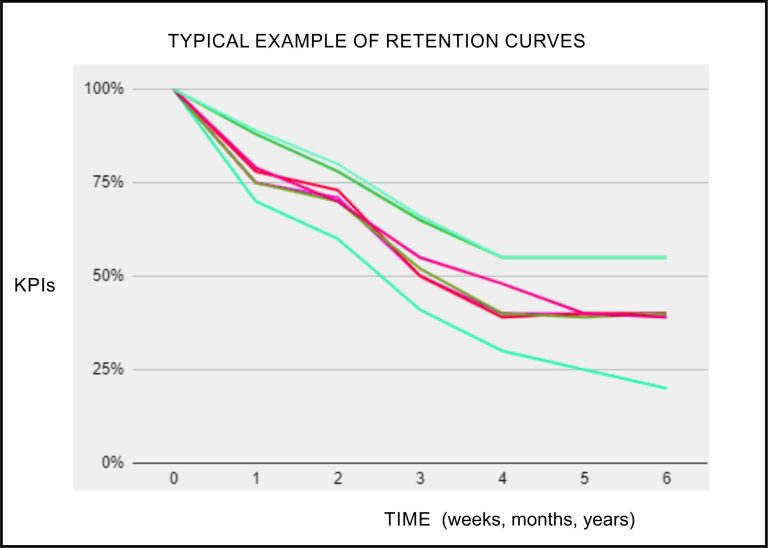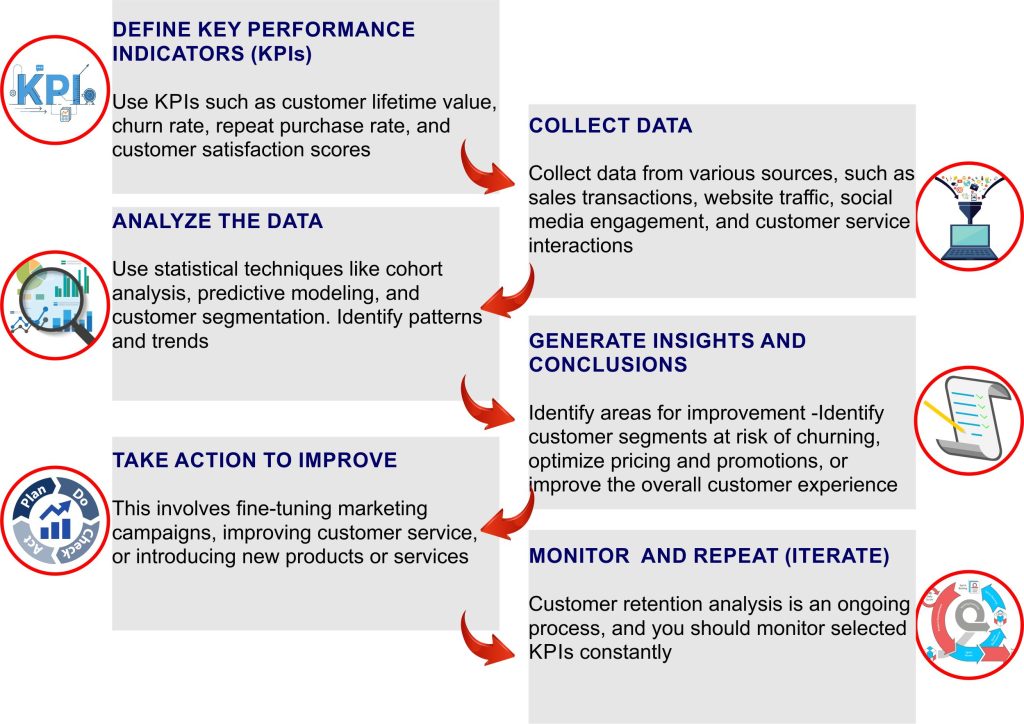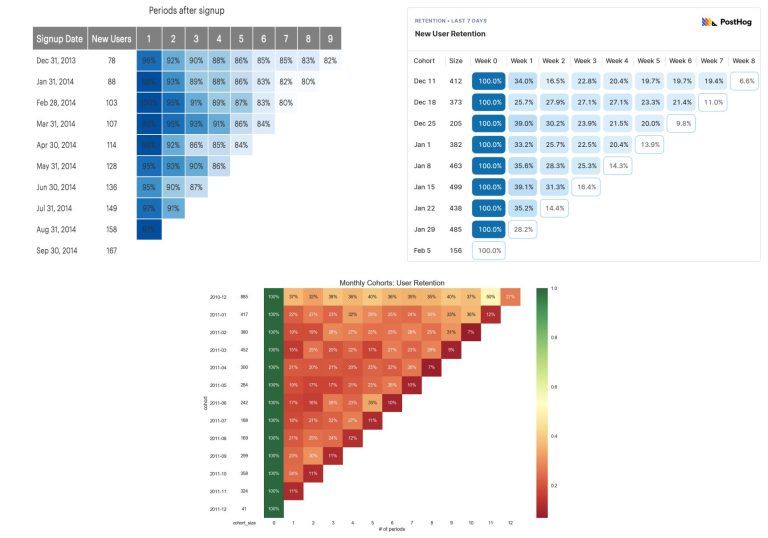It’s time to focus on customer retention and satisfaction!
Don’t settle for just one-time purchases.
Winning the loyalty of your customers can be a game-changer for your success.
We give you the solutions to keep your customers returning for more!
Customer Satisfaction and Retention
(7-minute read)

Table of Content
What is User Retention
User retention is a measure of customer loyalty essential for long-term success.
User retention can be improved through various strategies, such as improving the user experience, providing excellent customer service, and offering personalized promotions.
A high retention rate indicates that customers are satisfied with the product or service and are likely to continue using it in the future.

As an eCommerce store owner, understanding user retention is crucial for sales and profit. Repeat customers are more profitable and cost-effective than acquiring new ones. Retaining your existing customers should be a top priority.
Additionally, monitoring user engagement and feedback will identify areas of improvement, allowing data-driven decisions to enhance the overall user experience.
By prioritizing user retention, you will build a loyal customer base and boost your eCommerce store’s long-term success.
Proof that Customer Satisfaction and Retention matter
Case studies demonstrate that user retention is critical for building a successful eCommerce business.
Here are some case studies that clearly show the importance of customer satisfaction and retention.
- Amazon Prime: Amazon has successfully built a loyal customer base through its Prime subscription service, which offers free shipping, exclusive deals, and streaming services. According to a survey by Consumer Intelligence Research Partners (CIRP), Prime members tend to spend more money on the platform than non-Prime members. The report also found that Prime members have an impressive retention rate of 93% after their first membership year.
- LinkedIn: In a case study published by LinkedIn, the company reported that users who completed their profile were up to 40 times more likely to receive job opportunities than those with incomplete profiles. By prioritizing user engagement and encouraging users to complete their profiles, LinkedIn has successfully retained its users and created a valuable professional platform.
- Dropbox: Dropbox’s referral program is an excellent example of how personalized promotions can improve user retention. By incentivizing existing users to invite their friends and family to use the platform, Dropbox increased user retention by 60%. Referral programs effectively encourage users to engage with your brand and promote loyalty among your customer base.

Here are some statistical data that highlight the significance of customer satisfaction and retention in eCommerce:
- According to a study by Bain & Company, increasing customer retention rates by just 5% will boost profit by 25% to 95% (depending on the industry).
- A report by Adobe found that returning customers have a higher conversion rate than new customers. Returning customers have a conversion rate of 2.4%, while new have only 0.6%.
- A research study by Invesp found that acquiring a new customer can be up to five times more expensive than retaining an existing one.
- Another study by HubSpot reports that 93% of customers are likely to make repeat purchases with companies that offer excellent customer service.
- Research by Forrester found that 77% of customers would recommend a company to a friend after experiencing positive customer service.
Customer Retention Analytics
Customer retention analysis examines a business’s customer base to identify patterns and trends related to customer retention. It involves analyzing customer behavior, such as:
- purchase frequency,
- order value,
- the time between purchases,
to gain insight into customer loyalty and satisfaction.

Customer retention analysis aims to understand how to keep customers engaged and coming back for more.
Standard customer retention analysis techniques include cohort analysis, customer segmentation, and predictive modeling.
Step-by-step guide for the customer retention analysis
If you decide to perform a customer retention analysis, here are the steps you should follow:
- Define Key Performance Indicators (KPIs): KPIs are the metrics that businesses use to measure customer retention. KPIs include customer lifetime value, churn rate, repeat purchase rate, and customer satisfaction scores.
- Collect data: Customer data is collected from various sources, such as sales transactions, website traffic, social media engagement, and customer service interactions. The data must be cleaned and organized to enable effective analysis.
- Analyze the data: Use statistical techniques such as cohort analysis, regressions, design of experiment (DOE), predictive modeling, and customer segmentation to analyze the data. Identify patterns and trends related to customer retention. Minitab statistical software is one of the best for customer satisfaction and retention analysis.
- Generate insights and conclusions: Use the insights generated from the data analysis to identify areas for improvement in customer retention strategies. Identify customer segments at risk of churning, optimize pricing and promotions, or improve the overall customer experience.
- Take action to improve customer satisfaction and retention: Take appropriate action. Options include fine-tuning marketing campaigns, improving customer service, or introducing new products or services.
- Monitor and iterate: Customer retention analysis is an ongoing process, and you should monitor selected KPIs constantly. Use time charts, cause & effect diagrams, and Paretto analysis and adjust their strategies accordingly. Never stop analyzing and improving – that is the only way to stay ahead of competitors. Remember, they are doing the same.
Infographic - Step-by-step guide for the customer retention analysis
Click on the image to enlarge
Retention Curve
A retention curve, also known as a churn curve or survival curve, is a graphical representation of customer retention over time. It shows the percentage of customers who remain active and engaged with a product or service over a given period.

The retention curve typically starts at 100% and shows the percentage of customers remaining at each stage of the customer lifecycle.
For example, a retention curve for a subscription-based service might show the percentage of customers who remain subscribed after 1 month, 3 months, 6 months, and so on.
Retention curves help identify patterns in customer behavior and highlight areas where retention rates may be low. By analyzing retention curves, you can identify customer segments at risk of churning and take appropriate action to improve retention rates.
Retention curves can also be used to benchmark performance against industry standards and track retention strategies’ impact over time. They support data-driven decisions for long-term success.
Retention Chart
Retention charts, also known as cohort analysis charts or retention grids, are visual representations of customer retention and engagement over time, organized by customer cohorts.
A retention chart is typically a grid that shows the percentage of customers in each cohort who remain active and engaged with a product or service over time. The cohorts are typically defined by the month or quarter in which they first became customers.
For example, a retention chart for an eCommerce store might show the percentage of customers who made their first purchase in January, February, March, and so on and the rate of those customers who made a repeat purchase in each subsequent month.
Retention charts are useful for identifying trends and patterns in customer behavior over time and comparing retention rates between different customer cohorts. By analyzing retention charts, you will identify areas where retention rates may be low and take appropriate action to improve them for specific customer segments.
B2B Customer Retention and Satisfaction
B2B customers are generally more sensitive than individual e-commerce buyers due to ROI, long-term strategic planning, and higher product quality, reliability, and customer service expectations.

As the owner of a B2B eCommerce business, you should be aware of several important things to keep your customers satisfied and loyal:
- Building Relationships: B2B customers value relationships and personalized service more than B2C customers. Building solid relationships with your customers through regular communication, excellent customer service, and customized experiences is essential.
- Quality Products & Services: Ensure you offer top-quality products and services that address your customers’ unique needs and pain points.
- Customer Feedback: Soliciting and listening to feedback is necessary in a B2B world. Survey your customers regularly and show them that you genuinely care.
- Data-Driven Strategies: Analyze customer data to gain insights into their behavior and preferences. Use analytics tools to track customer behavior, identify trends, and measure the effectiveness of retention initiatives. Make decisions based on data.
- Proactive Approach: Keeping customers happy and retaining them for years is the first prerequisite for your success. Competition I severe and ruthless. Innovate constantly, and never stop improving your products and services.
How to Keep Customers Coming Back
Implementing personalization, loyalty programs, email marketing, excellent customer service, user-generated content, and an easy checkout process can create a positive customer experience, encouraging repeat purchases and fostering brand loyalty.

To keep customers coming back to your e-commerce store, you should try the following tips:
- Personalization: Provide a personalized experience for your customers. Recommend products based on their browsing and purchase history. They will feel valued and understood.
- Loyalty programs: Offer exclusive discounts or free shipping incentives to encourage repeat sales.
- Email marketing: Use email marketing to inform your customers about new products, promotions, and sales. Sending personalized emails will build a relationship and increase customer satisfaction, retention, and brand loyalty.
- Excellent customer service: Ensure customers are satisfied with their purchases. Respond promptly to inquiries and resolve any issues quickly and efficiently.
- Encourage reviews and shares: Encourage customers to share their experiences and review your products. This creates a sense of community and fosters brand loyalty.
- Easy checkout process: Make sure your checkout is simple and easy to use. This will reduce cart abandonment and increase conversion rates.
- Provide automated shipment tracking: Recently, there have been numerous apps you can integrate into your eCommerce website to provide a 24/7 order tracking option. Your customers will love it.
I Need You to Increase the Number of Customers
When your sales and profit are unsatisfactory or declining, remember that customer satisfaction and retention are critical and the least expensive ways to improve your dire situation.

So, what should you do to increase the number of customers? We suggest you refocus and try to increase
- number of purchases
- average purchase value
- positive reviews
- shares on social media
- cross-sell and upsell.
All mentioned techniques are 100% guaranteed way to success. All you need to do is reach out to your existing customers. Do not waste time and money designing new products, penetrating new niches, or implementing some expensive marketing strategies.
Utilize the power of customer satisfaction and retention. Focus your efforts there, and you’ll be awarded tenfold.
Step-by-step guide to increase the number of customers (or sales)
Here are step-by-step instructions for bringing more customers or/and sales by utilizing customer retention:
- Assess your current customer retention efforts
- Review customer data, such as purchase history and feedback,
- Identify which customers are most valuable and engaged.
- Make a list of opportunities to improve customer retention using the techniques we listed above
- Continuously improve your retention strategies by monitoring customer feedback, analyzing customer behavior, and staying up-to-date on industry trends and best practices
- Stay engaged with your customers by regularly communicating with them, providing valuable content and resources, and seeking feedback to improve your products or services
How can shipping boost customer satisfaction and retention and bring more sales
Order shipping can be daunting and nerve-wracking. There is a 100% successful way to make the best of it and increase sales and profit.

There is one guaranteed and proven way to increase customer satisfaction and retention and increase sales by 10% in less than a week.
Integrate order tracking software on your eCommerce website and experience positive results quickly.
How?
Good order tracking software:
- Reduces anxiety: It provides customers with real-time updates on the status of their orders.
- Increases convenience: Customers can check on the status of their orders quickly and easily from anywhere, without having to contact customer service or wait on hold.
- Offers opportunities for upselling: With order tracking software, businesses can automatically send upsell emails to customers during the course of their order journey, providing additional product recommendations and increasing sales opportunities.
- Demonstrates care: Regular email notifications throughout the order process, from order confirmation to delivery, show customers that you care about their experience and are committed to keeping them informed and engaged.
- Provides transparency: By offering detailed information about shipping details, expected delivery dates, and any potential delays, order tracking software provides transparency and visibility into the order process, which can improve customer trust and confidence.
- Enhances customer service: When customers have questions or concerns about their orders, order tracking software allows customer service representatives to quickly and accurately respond with updated information, leading to a positive customer service experience.
The best order tracking software for eCommerce
When you decide to follow our advice to boost customer satisfaction and retention while utilizing modern technology, we strongly recommend Track Mage.

TrackMage is an exceptional order-tracking software that has received numerous positive feedback. See for yourself; check now TrackMage case studies.
Some of TrackMage’s key features include:
- real-time package tracking,
- email and SMS notifications,
- customizable tracking pages,
- detailed delivery information
- integration with a variety of e-commerce platforms, such as Shopify and WooCommerce,
- sales boost on autopilot by utilizing the upsell techniques through automated emails during the shipping period.
Customer Retention Technology
Lorem ipsum dolor sit amet, consectetur adipiscing elit. Ut elit tellus, luctus nec ullamcorper mattis, pulvinar dapibus leo.

Using technology can be a great way to increase sales and profit in your e-commerce store. Technology has revolutionized how businesses operate, and e-commerce stores are no exception.
Here are some ways that technology can help increase sales and profit:
- Improved customer experience: By utilizing technology such as chatbots, personalized recommendations, and easy-to-use checkout processes, you can provide a better customer experience that encourages customers to make purchases and return in the future.
- Better data analysis: Technology allows you to collect and analyze customer data at a level that was impossible just a few years ago. This data can help you identify trends, preferences, and pain points in your customer base, allowing you to optimize your marketing efforts and improve customer retention.
- Streamlined operations: By automating repetitive or time-consuming tasks, technology can help you streamline your operations and reduce costs. This can free up resources to focus on revenue-generating initiatives and improve profitability.
- Expanded reach: Technology can help you reach new audiences through social media advertising, SEO optimization, and other digital marketing channels. This can help you grow your customer base and increase sales.
- Easy feedback and reviews: Technology allows you to automate feedback requests, making it easy for customers to leave reviews and provide feedback on their experience with your store. This can be done through email requests, pop-ups on your website, or other methods.
3-sentence Conclusion
In conclusion, customer satisfaction and loyalty are critical factors in driving sales growth and achieving long-term success in e-commerce.
By prioritizing the customer experience and investing in strategies and technologies that enhance satisfaction and build loyalty, businesses will increase customer retention, attract new customers, and establish a strong foundation for sustainable growth over time.
Ultimately, the success of any e-commerce business depends on its ability to provide a high-quality customer experience that prioritizes satisfaction and loyalty above all else.


